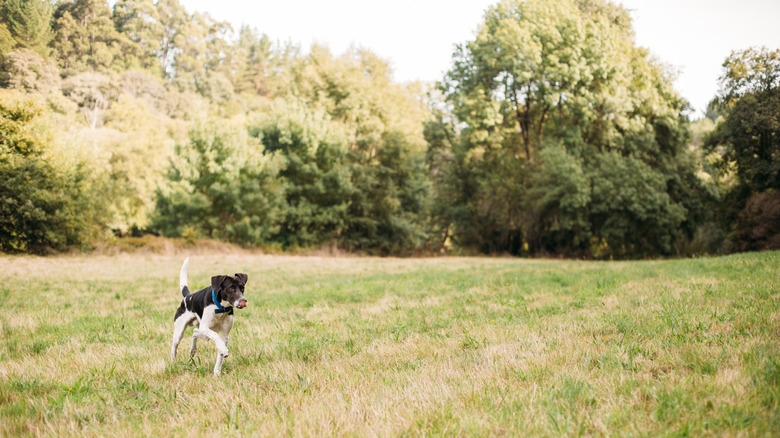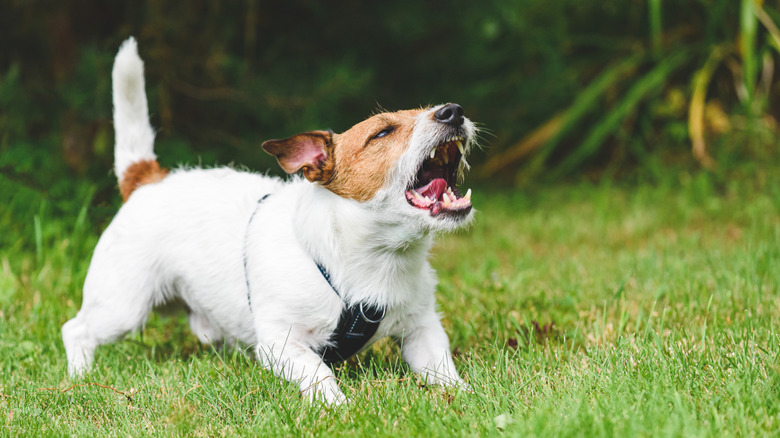Think Twice Before Installing An Invisible Fence To Keep Your Dog In Your Yard - Here's Why
Invisible fence technology has been around since the early 1970s. Since then, thousands of pet owners have added the system to their yards. While the technology offers several benefits for both humans and dogs, it comes with drawbacks, too. For one, invisible fencing can lead to unwanted behaviors in dogs, which could lead to more problems for them and humans. It could also fail to properly contain a dog or cause injury. With these risks in mind, you might want to consider other ways to keep your pup in your yard that don't involve an invisible fence.
People often opt for invisible fences because of HOA or financial restrictions. In any case, installing a dog run or exercise pen can be a good alternative. You can purchase them in various lengths and heights, with or without a roof cover, and pay less than you would for an underground barrier system. Even dog runs for large breeds have a price tag lower than that of some brands of invisible fence, the latter of which starts at about $350.
Using a long dog leash is another option. Just be sure to monitor your dog regularly, and never leave it outside on a long leash when you're not home. Although a physical fence would likely be the most reliable, and safest option to keep a dog in a yard, it's not a possible arrangement for everyone. However, that doesn't mean an invisible fence is your only other option, especially when you consider these dangers.
Invisible fence collars can cause behavioral issues in dogs
Invisible fence technology involves using a special collar that issues a warning tone to the dog wearing it before delivering a static shock. Dog owners typically hope the audible warning alone will always be enough to keep their dogs contained, but unfortunately, this isn't always the case. Many dogs end up getting shocked, resulting in long-lasting fear or even aggression.
Dr. Jennifer L. Summerfield, a veterinarian and dog trainer, shared her thoughts on the issue with the Humane Society of Pulaski County, based on her own experience. As a teenager, her dog received a "very mild correction" shock from an invisible fence collar that left him terrified to enter the yard again for three weeks. Another owner shared on Reddit how their dog seemed to develop PTSD from their invisible fence shock collar; four months after being shocked, he ran away at the sight of the collar and was too spooked to go outside, so he hid in his crate.
It's natural for a dog to be confused and scared about a random, unprovoked moment of discomfort. Without being certain of the source, it could associate the shock with whatever's next to them at the time — including another dog. For example, if your dog were to get shocked while rolling around playfully with the neighbor's dog, it could respond with anger and direct it toward the other dog. This behavior, called redirected aggression, could lead to owners being forced to break up a dog fight.
Invisible fence collars can fail to contain a dog or cause injury
While some dogs develop extreme fear or aggression as a result of a shock collar, others are unfazed by the shock, causing them to exit their invisible yard boundaries. This could cause a range of problems, putting your dog's safety and that of other animals or humans at risk. A dog could get hit by a car, get into a scuffle with another animal, or even attack a human, if allowed to freely roam the neighborhood.
An additional risk associated with an uncontained dog involves external factors within your yard. If no physical boundary exists to keep a dog in a certain area, no physical boundary exists to keep things out either. This means that another animal or an ill-willed person could easily walk into your yard and harm or even take your dog.
Another possibility is that the invisible fence collar could injure your dog's neck if left on for too long. Some manufacturers of underground fence technology recommend leaving the collar on for no more than 12 hours at a time to prevent pressure necrosis from the shock prongs. This is a condition in which the constant pressure of the prongs restricts blood flow, leading to tissue damage. Some people call this a dog collar burn, although technically, no burning actually occurs from the shock or the prong pressure. While an invisible fence has some benefits, you may not find these risks worth the cost of an invisible fence, so it's best to make a decision carefully.


